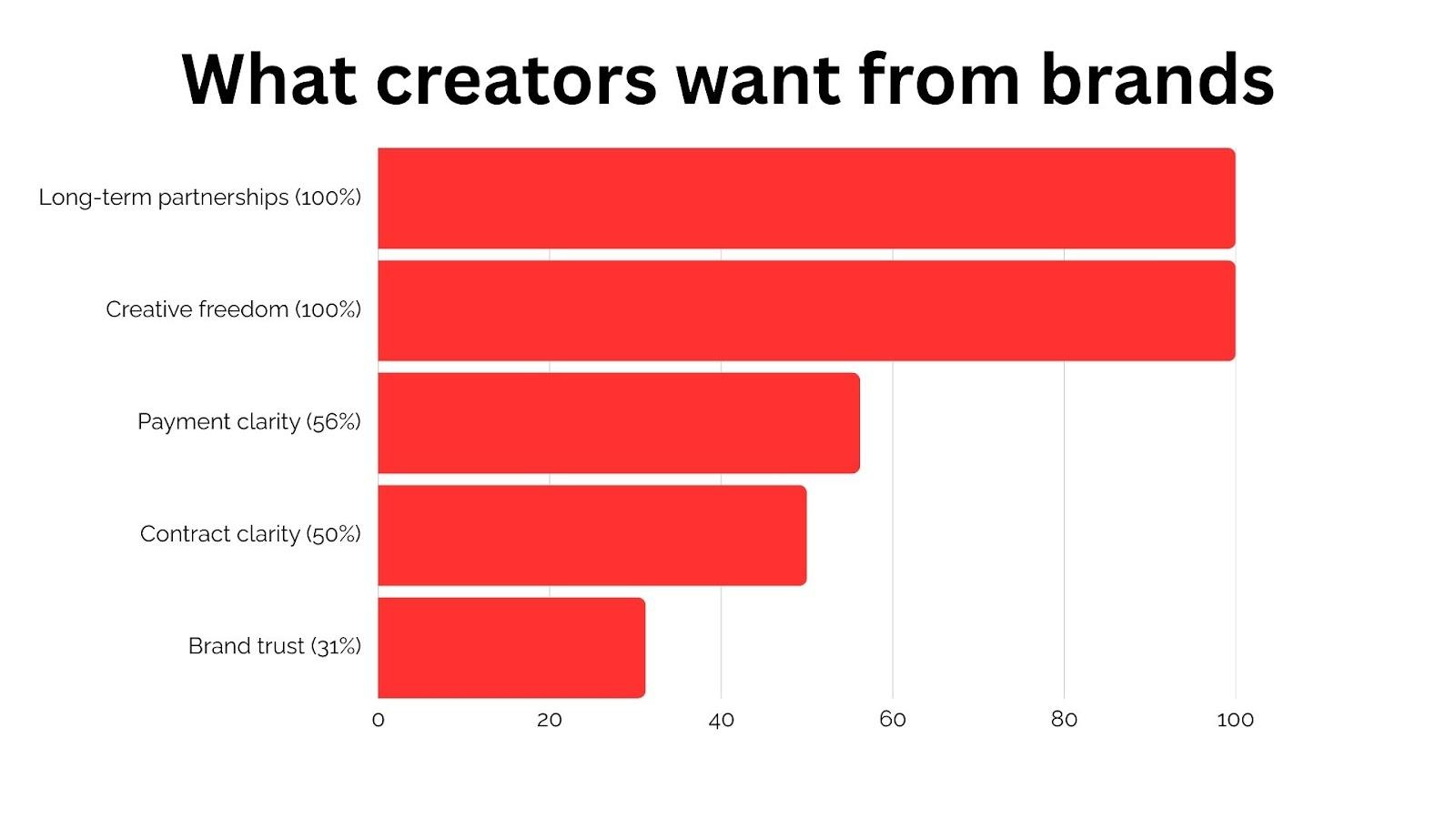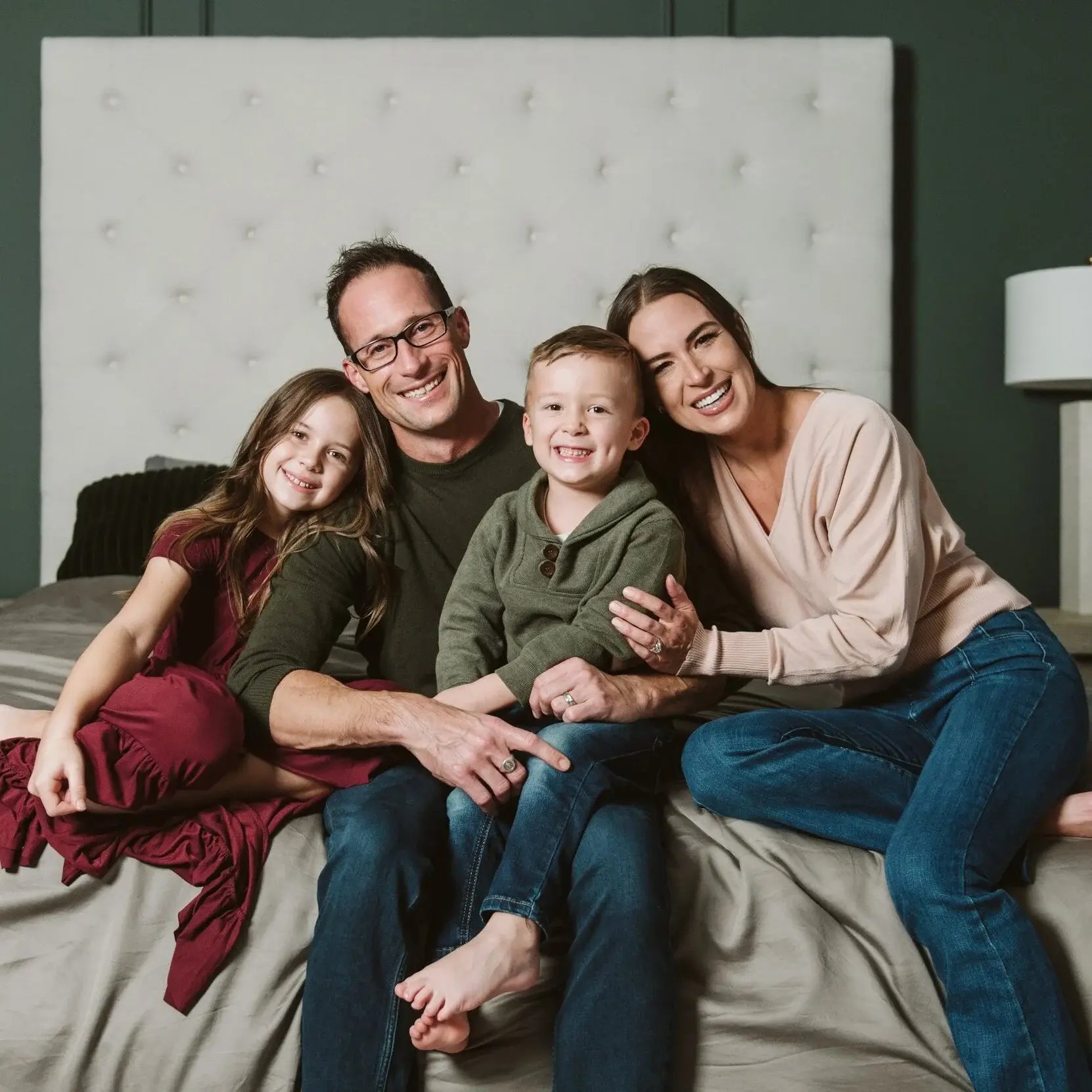-
Long-term creator partnerships
-
Creative freedom & trust
-
Data transparency
-
Timely, fair payment
What Creators Really Want From Brands In 2025 (And What They’ll Expect In 2026)

Partnering with creators is one of the top marketing methods for brands in 2025. This is why 80% of brands have maintained or increased their influencer marketing budgets, with nearly half (47%) raising budgets by 11% or more.
To quantify the value of creators to brands, on average, businesses earn $6.50 in revenue for every $1 spent on influencer campaigns. That’s a huge ROI, which is why it’s so important to understand what creators want and need to succeed.
We interviewed 16 creators and industry experts to learn more about what creators need most right now, and how they expect partnerships to evolve in the coming year.
Here’s what came up most often and what these responses mean:

1. Creators want aligned, long-term partnerships

Nearly every creator we spoke to emphasized the need to move away from one-off deals and toward ongoing relationships. Long-term work gives them the space to create better content, understand their brand partner, and deliver more impact over time.
Chris Kirksey, Founder & CEO at Direction, offers insight into what this looks like. “A healthy creator-brand relationship today is a relationship with aligned goals, delivering authentic and impactful messaging to a shared audience. Creators have the freedom to bring authenticity with their craft that impacts engagement while brands, on the other side, must offer fair compensation and clear expectations,” he says.
Sam Speller, Founder of Kenko Matcha, adds to this sentiment.
“The best creator-brand partnerships are based on continuity and mutual values, not transactional endorsements. Our best collaborations have been with wellness creators who actually integrate our ceremonial-grade matcha into their routine over months—not by doing just one post.”
Speller explains how ongoing partnerships have more impact on their bottom line such as a multi-week, creator-led series turningone message into a story arc where habits form, trust compounds, and results follow.
At Kenko, Speller’s team put this idea into practice. Their company produced a 12-week creator-led series (instead of one influencer post), and saw a 37% lift in subscriptions—evidence that consistent, values-aligned content earns deeper engagement over time.
Strategies to build successful, long-term partnerships:
- Align on the “why.” Get everyone on the same page up front by writing down the audience you want to reach, the outcomes you expect, and the problem you’re solving together. Keep it simple—one page with goals and non-negotiables (e.g., compliance requirements, brand voice notes, claims you can and can’t make).
- Set creators up for success. Ship product samples early. Share a short audience/context brief, brand assets, and a “creative sandbox” doc that spells out what’s flexible vs. what’s off-limits. Think of it as giving creators the tools without dictating the build.
- Think series, not single posts. Replace one-off campaigns with a plan that unfolds over weeks or months. Build in milestones for concept approval, content drops, and performance check-ins. This lets stories develop, habits form, and trust compound.
2. Creators want to take the creative lead

Creative autonomy also came up in every conversation. Creators want to be trusted to do what they do best—connect with their audience in a way that feels real.
The best work happens when creators help shape the idea and carry it forward—in their own voice. That means giving creators a seat at the strategy table, setting clear goals, and giving them room to make creative decisions that align with what their audience trusts.
“The best relationships I’ve had are when brands value my audience insights, give me room to create content in my authentic style, and provide clear communication on expectations, timelines, and goals,” says Ciara Strickland, creator behind The New Mixx™ and former influencer strategist at Later.
“When that balance exists, both sides win—the brand gets content that resonates, and I get to build long-term credibility with my audience.”
Ciara’s insight is a great blueprint for what works:
- Align on the outcome and the audience
- Set expectations and timing
- Let the creator steer the creative
When creators lead the execution, the content feels natural to the community that already trusts them, which strengthens both performance and brand equity.
Zazie Kanwar-Torge, creator of Well Meaning Neurotypicals and founder of Zazie Productions, echoes this sentiment:
“The best partnerships I’ve had gave me space to shape the message in my own voice—even if it meant leaning into irony, memes, or chaos—because that’s what my audience trusts. A healthy relationship feels less like ‘sponsored content’ and more like cultural cross-pollination.”
Kanwar-Torge emphasizes the advantage of letting creators bring their unique style to the project—especially in Gen Z and niche communities where style and subtext carry as much weight as the message itself. When creators lead, they translate the brand’s goals into formats and references that resonate well.
How to put this into practice:
- Co-develop the strategy. Sit down with the creator at the start. Define who you want to reach, what success looks like, and the non-negotiables (claims, compliance, tone). Capture it all in a short brief you both sign off on.
- Let the creator own the creative. You approve the goals and outcomes, but the creator chooses the format, style, and execution. For example, they decide if it’s a TikTok series, a meme thread, or a long-form video.
- Build for consistency. Replace one-offs with an ongoing calendar. Commit to a series (e.g., 6–12 weeks) where the creator can tell a continuous story, build habits with their audience, and refine based on performance check-ins.
3. Creators want to be trusted to do what they do best from day one

Giving creators full creative control may feel scary to some brands. Creators, however, emphasize that they see the best results when brands trust them to do what they do best—collaborate and create.
Nearly one-third of responses mentioned the importance of mutual respect. The best partnerships are built when brands don’t micromanage them and trust creators to take the lead.
“I’ve noticed the best results come when brands truly trust me to interpret their goals in my own voice and creative style. [One] campaign flourished because I was brought in early, given space to pitch concepts, and treated as a partner rather than just an ad channel,” says Angel Sanchez, founder and photographer at Wanderlust Portraits.
From the brand side, trust is built through simple structure: clarity on the outcome and audience, documented guardrails, and a process that supports fast, focused collaboration.
Kate Ross, PR Specialist at Irresistible Me explains how they make this work at their company:
“We agree on the ‘why’ (outcomes, audience, guardrails) and let the creator own the ‘how.’ There’s transparent compensation and usage terms up front, fast feedback, one point of contact, and simple success metrics we both see. It should feel like co-creation, not a transaction,” says Ross.
How to put this in practice:
- Invite creators in early. Bring them into the briefing phase, not after. Define audience, outcomes, and guardrails together so the strategy is aligned before any concepts are developed.
- Build trust with structure. Set clear goals, outline what’s off-limits, and commit to quick feedback loops. This gives creators freedom to lead while keeping the partnership focused and reliable.
- Let creators lead execution. You sign off on the “why” and desired results; they decide how to deliver—whether it’s short-form video, a post series, or another format that fits their voice and audience.
4. Creators want access to performance data

Many creators told us they can’t improve what they can’t see. Access to performance data helps them understand what’s landing, what’s not, and how to adjust in real time.
“Brands should offer clearer communication and better data insights so creators can refine their strategies,” says Khris Steven, Founder at KhrisDigital. “[They] need to give creators the ability to track their performance more easily, giving them the information they need to optimize content.”
Without that feedback loop, creators are guessing. With it, they can double down on what works, drop what doesn’t, and drive measurable growth for both sides.
How to put this into practice:
- Share performance data. Give creators access to dashboards or regular reports so they can see exactly which posts, formats, or messages are resonating.
- Be transparent about metrics. Define KPIs—like conversions, engagement rates, or subscriber lifts—up front, so creators know what you’re measuring against.
- Encourage iteration. When content hits or misses, explain the why (audience behavior, timing, creative choices) and work with creators to adjust the next round.
5. Pay creators on time

Want your best creators to continue touting your name (and recommend you to other creators)? Pay them on time.
More than 50% of respondents mentioned the importance of clear payment terms. Yes, creators want to be paid fairly, but they also want to be paid on time.
“Our in-house metrics within our organization indicate that creatives who are paid within 10 business days of project completion are 40% more likely to ask for a repeat collaboration,” says Luca Dal Zotto, Co-founder of Rent a Mac. “Timely and transparent payment is not negotiable.”
If a creator has to chase down invoices or dig through messy threads to find key information, they’re less likely to come back for the next campaign.
Leah Miller, Marketing Strategist at Versys Media, says staying organized and paying on time is a matter of trust.
“Mutual trust and clear boundaries around feedback and timelines made it sustainable for both sides,” she says. “Reliable payment systems, streamlined contracts, and centralized communication all matter as much as creative freedom.”
How to put this into practice:
- Agree on compensation and incentives. Document base rates, payment schedule (e.g., net-10 or net-15), covered expenses (like travel or production), and any extras such as performance bonuses or revenue share. Put the full package in writing before work begins.
- Sign a contract. Formalize the agreement. Spell out deliverables, timelines, usage rights, and payment terms so both sides know exactly what to expect and are protected.
- Pay on time. Use reliable payment systems, stick to the agreed schedule, and confirm receipt with the creator. If delays happen, communicate immediately and outline a new date.
The road ahead: turn creator collaborations into competitive advantage
Brands that treated influencer activations as one-off impressions have already hit a ceiling. The next wave of growth belongs to teams that operationalize everything creators asked for in our research—long-term relationships, real creative autonomy, radical transparency, and on-time pay backed by clear data loops.
What this means in practice:
- Shift your budget mix from campaigns to creator “retainers.” Commit resources you can defend for at least two quarters. You’ll buy compounding trust and a faster path from awareness to revenue.
- Build a two-way performance OS. Marry first-party commerce data with creator analytics and give partners access. When they can see what moves the needle, optimization becomes a shared habit, not a quarterly post-mortem.
- Audit your operations for friction. Slow legal reviews, unclear usage rights, net-30 payment terms—each is a silent tax on your ability to secure top talent. Fix them now or lose the best voices to competitors who already have.
Treat your creators like strategic partners today, and by 2026, you’ll have a winning, creator-powered growth engine.
The Largest Creator Agency in the World
Elevate your brand’s influence with award-winning, always-on marketing services.




-1.jpg?width=300&height=300&name=an%20email%20image%20for%20our%20new%20newsletter%20with%20the%20text%20_Decoded_%20BFCM_%20its%20about%20the%20holidays%2c%20shopping%2c%20retail%2c%20spending%20so%20gifts%2c%20shopping%20bags%2c%20money%20(1)-1.jpg)